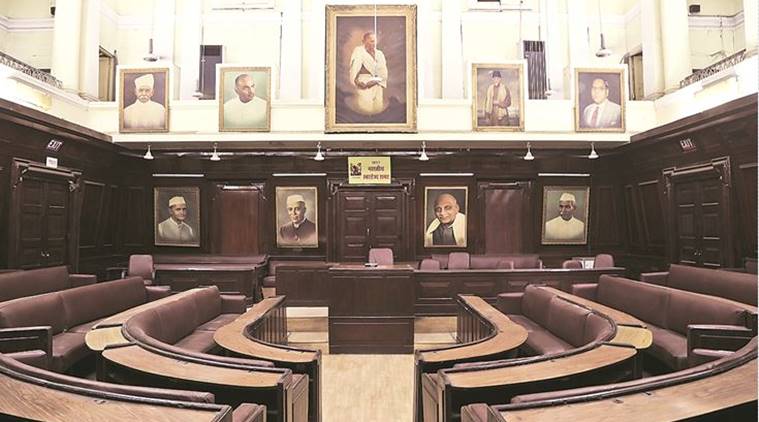 Spread across 16 acres, the building was once the office of the erstwhile Delhi Municipal Corporation. It is now used to hold civic body meetings. (Express photo by Abhinav Saha)
Spread across 16 acres, the building was once the office of the erstwhile Delhi Municipal Corporation. It is now used to hold civic body meetings. (Express photo by Abhinav Saha)
As one enters the century-old Town Hall in Chandni Chowk, a portrait of Mahatma Gandhi unveiled by Sardar Vallabhbhai Patel and a symbolic key to Delhi that was given to the mayor before the MCD was trifurcated greets visitors. Built during 1860-65, the British-era building is set to be turned into a heritage museum and hotel, with the North Delhi Municipal Corporation’s standing committee recently clearing a proposal on the same.
Spread across 16 acres, the building was once the office of the erstwhile Delhi Municipal Corporation, and has been lying vacant since it was shifted to the Shyama Prasad Mukherjee Civic Centre. Town Hall, in the meantime, has fallen into a decrepit state — rooms that were once the offices of mayors, commissioners and other officials are covered in dust and hanging wires, while the walls are crumbling due to seepage. Now, the only places that are frequently visited are the halls where the corporation holds zonal meetings.
“The building has over 50 rooms and two meeting halls, and is presently used by the corporation to hold meetings. The corporation also rents it out for movie shootings and meetings, through which it earns Rs 5-Rs 6 lakh a year. Once the hotel project is executed, the civic body will earn around Rs 2 crore per month,” said Yogendra Singh Mann, spokesperson of the NDMC.
According to records available with the corporation, Town Hall was planned before India’s First War of Independence in 1857 to serve as an office for the municipality, chamber of commerce, a literary society, and a museum to “improve the local minds.” It was built with a provincial fund of Rs 30,000, which was collected as subscription from Indian citizens. Initially known as the Lawrence Institute, it housed the Delhi College of Higher Studies. In 1866, the municipality bought it for Rs 1,35,475.
The meeting hall on the ground floor has 50-year-old portraits of national leaders such as Jawaharlal Nehru, BR Ambedkar, Sardar Vallabhbhai Patel and Subhash Chandra Bose. “Some of the rooms are used for keeping records. We are converting the records electronically so that they do not get destroyed when the Town Hall is vacated,” said an official.
Earlier, a bronze statue of Queen Victoria stood in the hall, but post-Independence, it was replaced with a statue of Arya Samaj leader Swami Shraddhanand. This statue now stands in the premises of the Delhi College of Art. The press building next door, which will also be given the status of a heritage hotel, is used for storing the corporation’s materials, while the top floor is used for storing records.
Yellow brick and stone was used in its construction, while the exterior sports numerous stone carvings. Veena Vermani, standing committee chairman of North Corporation, said, “We will not allow changes to the facade of the building. Changes can be made inside, but it will be as per the norms of heritage conservation and regulation.”
INTACH’s Delhi Chapter Convenor Swapna Liddle said, “This is not a monument… so changes will be allowed inside… so that wirings are properly fixed and bathrooms constructed. But the corporation should also ensure that the company that gets the contract does not alter its heritage element. “There have been several projects in Rajasthan where private hotels have stepped in to maintain heritage parts of a property,” she added.